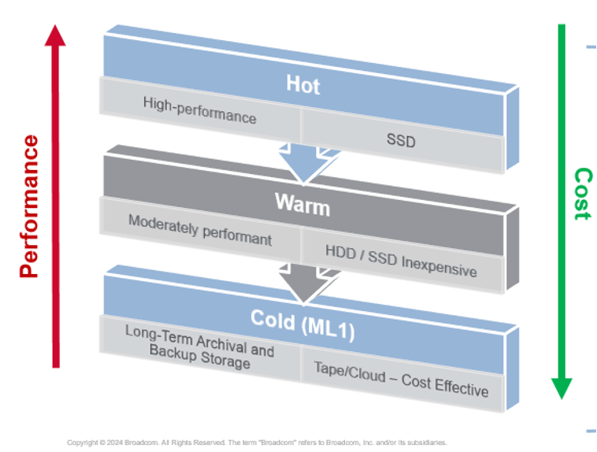Part II: Object Storage: The Evolution and Simplification of Tiered Enterprise Storage
In the ever-evolving landscape of data storage and management, object storage has emerged as a game-changer. It represents a significant shift in how organizations store and manage their data. In this blog, we will explore object storage and how it has revolutionized traditional enterprise storage, and discuss data security in the context of object storage. We will also describe how to set up object storage in a hybrid IT environment and how it can help extend the life of your storage infrastructure and drive down long term cold storage costs.

The Evolution of Enterprise Storage
Historically, enterprise storage has been a complex and costly endeavor. Traditional storage systems often require extensive hardware investments, complex configurations, and intricate tiered storage models to accommodate the growing volumes of data. This approach has resulted in several challenges:
- Complexity: Managing tiered-storage architectures and maintaining multiple storage systems are intricate and resource-intensive.
- Cost: The capital expenditures on hardware and operational expenses for managing complex storage infrastructures is substantial.
- Scalability: Adapting to changing data volumes and workloads is challenging and often requires significant lead time.
Object storage addresses these challenges head on, providing a more straightforward, cost-effective, and scalable solution.
What is Object Storage?
Object storage is a highly scalable, durable, and secure cloud storage service. Unlike traditional storage systems, object storage treats data as objects and organizes them into containers within a flat namespace. This object-based storage architecture simplifies data management, reduces complexity, and offers several benefits:
- Scalability: Object storage automatically scales to accommodate any volume of data without the need for manual intervention.
- Durability: Object storage systems are designed for high levels of data durability, ensuring data remains available and reliable.
- Cost-Effective: With a pay-as-you-go pricing model, organizations only pay for the storage they use, eliminating the need for substantial upfront investments.
- Simplicity: The object storage API is straightforward and offers a user-friendly interface to make it easy to store, retrieve, and manage data.
Data Security in Object Storage
Data security is paramount in any storage solution, and object storage is no exception. Cloud providers offer a range of security features to protect data stored in object storage, including:
- Encryption: Object storage supports both server-side and client-side encryption, ensuring data remains confidential and secure during storage and transfer. Storage backup products such as CA 1™ Flexible Storage™ can support your data transfer and encryption requirements.
- Access Control: Implement access controls and policies to specify who can access object storage containers and objects.
- Versioning: Many object storage solutions enable versioning of objects, allowing you to track changes and recover previous versions of data, enhancing data protection.
- Data Classification: You can implement data classification and tagging to identify sensitive information and enforce access policies accordingly.
Setting up Object Storage in a Hybrid IT Environment
A hybrid IT environment combines on-premise infrastructure with cloud services, offering flexibility and scalability. Integrating object storage into a hybrid setup can be achieved by using following these steps:
- Assessment: Evaluate your data storage needs, identifying which data should reside on-premises and which data can be moved to object storage.
- Connectivity: Establish secure network connectivity between your on-premise data center and the cloud provider's infrastructure.
- Hybrid Storage Gateway: Utilize hybrid storage gateways or connectors to seamlessly connect your on-premise applications with object storage.
- Data Migration: Use appropriate tools for data migrations from on-premise storage to object storage.
- Access Control: Implement access controls and policies to control access to your object storage data from both on-premise and cloud resources.
- Monitoring and Management: Utilize cloud provider monitoring and management tools to effectively manage your object storage resources.
- Backup and Disaster Recovery: Implement data backup and disaster recovery strategies that leverage the durability and availability of object storage. Products like CA 1™ Flexible Storage™ and Disk Backup and Restore from Broadcom are proven solutions with direct-to-the-cloud support for your enterprise data.
In conclusion, object storage has transformed the landscape of enterprise storage by simplifying data management, reducing costs, and enhancing scalability. Its robust security features make it a secure choice for storing sensitive data, and its seamless integration into hybrid IT environments further extends its utility. As organizations continue to grapple with the challenges of data growth and security, object storage remains a key player in the evolution of storage solutions.
Stay tuned for part 3 of this blog series, “Disk Backups Versus Tape Backups,” which covers disk, tape, and cloud object storage options.
Learn how you can include CA 1 Flexible Storage as part of your Mainframe Data Storage strategy

 Copyright © 2005-2025 Broadcom. All Rights Reserved. The term “Broadcom” refers to Broadcom Inc. and/or its subsidiaries.
Copyright © 2005-2025 Broadcom. All Rights Reserved. The term “Broadcom” refers to Broadcom Inc. and/or its subsidiaries.
Comments